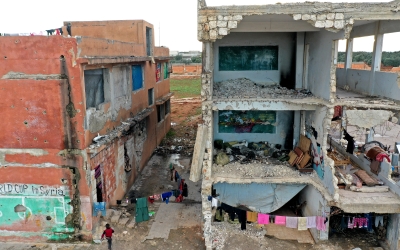At least 37 million displaced by America's two-decade 'war on terror': Report

Tens of millions of people have been displaced as a direct result of the United States' so-called "war on terror", a report by Brown University has found.
A 30-page report released by the university's Costs of War project on Tuesday claimed that at least 37 million people, mostly civilians, had been displaced from Afghanistan, Iraq, Pakistan, Yemen, Somalia, the Philippines, Libya and Syria - countries largely targeted by America's two-decade "war on terror".
The study said "the scale of displacement across the eight countries surveyed likely reaches levels only seen in the Second World War".
According to the Brown report, the figure was a conservative estimate and the real number could range between 48 million and 59 million.
"US involvement in these countries has been horrifically catastrophic, horrifically damaging in ways that I don't think that most people in the United States, in many ways myself included, have grappled with or reckoned with in even the slightest terms," David Vine, a professor of anthropology at Washington's American University and lead author of the report, told the New York Times.
New MEE newsletter: Jerusalem Dispatch
Sign up to get the latest insights and analysis on Israel-Palestine, alongside Turkey Unpacked and other MEE newsletters
While the US was not the only cause for the forced migration, researchers said it had played either a dominant or contributing role in the conflicts that caused displacement.
In some cases, the displacement caused by the US's post-9/11 wars had "torn apart" neighbourhoods, communities and entire societies.
"In Iraq, for example, sectarian fighting and displacement following the 2003 US-led invasion destroyed what had been a 'mosaic patchwork' of mixed communities, in which Shia and Sunni and other religious and ethnic groups lived side-by-side, working together and intermarrying," the report said.
"What replaced it was an Iraq divided into three large ethno-sectarian regions defined by increasingly homogenous Shia, Sunni and Kurdish identities. In cities like Baghdad, US forces contributed to the hardening of ethno-sectarian divisions."
Several Syrian opposition activists objected to the findings of the study on their home country, stressing that mass displacement was largely caused by attacks carried out by the government of President Bashar al-Assad and its allies.
The conflict began in 2011 after peaceful protests against Assad, but it quickly escalated into a military conflict with regional and international powers backing rival groups on the ground. The United States has trained and equipped local Syrian forces and conducted bombing campaigns largely aimed at militant groups including al-Qaeda affiliates and the Islamic State.
Forcibly returned
Of the 37 million or more displaced, researchers estimated that a little over 25 million people had returned to their countries of origin or, among internally displaced persons (IDPs), to the areas from which they had fled.
"While return can be a sign of improved living conditions and greater peace and security at home, the scale and significance of refugees and IDPs returning home should be interpreted carefully," the report warned.
"To start, some of the 25.3 million IDPs were not among the original 37 million displaced. This is because international organisations count the children of returned refugees or IDP mothers as 'returnees.' Born in displacement, these children return to places and homes they have never known."
In other cases, such as Yemen, some IDPs returned to homes near the frontlines of fighting because they could not afford to leave the country or because they could not afford the costs of living in the areas where they had fled to safety.
Researchers found that others had also returned because they were fleeing new violence, or because host governments had deported them or pressured them into leaving "with threats or by cutting off employment and other necessities, among other tactics".
"In other words, some 'returnees' are actually the victims of further forced displacement," the report said.
"Even in the best circumstances of return, going home does not erase the experience of fleeing for one’s life or the struggle to survive after being displaced," researchers warned.
"The experiences of wartime displacement are profound, traumatic and long-lasting. Returning home should not be equated with a return to normal or to a prior state of being."
Middle East Eye delivers independent and unrivalled coverage and analysis of the Middle East, North Africa and beyond. To learn more about republishing this content and the associated fees, please fill out this form. More about MEE can be found here.






